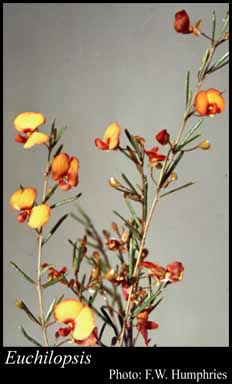- Reference
- Australas.Chem.Druggist 5(13) (1882)
- Name Status
- Current

Scientific Description
Family Papilionaceae. Mirbelieae.
Sometimes included in Leguminosae.
Habit and leaf form. Small, slender shrubs (prostrate to ascending, many-stemmed). ‘Normal’ plants to switch-plants (the leaves small and distant). Plants unarmed. Plants with neither basal nor terminal concentrations of leaves; to 0.6 m high. Xerophytic. Leaves small to medium-sized (8–32 x 1 mm); not fasciculate; alternate; distantly spiral; not decurrent on the stems; not imbricate; shortly petiolate. Petioles wingless. Leaves non-sheathing; simple; epulvinate. Leaf blades dorsiventral; entire; rolled (margins revolute, hiding the abaxial surface); narrowly oblong, or linear; narrowly oblong, or linear. Leaves without stipules. Leaf blade margins entire; revolute. Leaf anatomy. Hairs present; complex hairs present. Complex hairs peltate. Stem anatomy. Secondary thickening developing from a conventional cambial ring.
Reproductive type, pollination. Fertile flowers hermaphrodite. Unisexual flowers absent. Plants hermaphrodite. Floral nectaries present. Nectar secretion from the disk. Entomophilous.
Inflorescence and flower features. Flowers scarcely aggregated in ‘inflorescences’, or solitary (solitary or paired in the distant axils of flowering stems); crowded at the stem bases; axillary; 1–2 per axil; in pairs, subtended by a common bract, or not in pairs subtended by a common bract. Inflorescences simple, or compound. Flowers pedicellate (the pedicels 7–20 mm long); bracteate (the bracts minute, at the pedicel bases); (bi-) bracteolate. Bracteoles persistent (minute, triangular, on the upper half of the pedicel). Flowers small to medium-sized (the standard 7–10 mm long); very irregular; zygomorphic. The floral asymmetry involving the perianth, or involving the perianth and involving the androecium. Flowers papilionaceous; 5 merous; tetracyclic. Floral receptacle developing a gynophore. Free hypanthium present, or absent. Hypogynous disk present; intrastaminal. Perianth with distinct calyx and corolla; 10; 2 -whorled; isomerous. Calyx present; 5; 1 -whorled; gamosepalous; lobed; toothed. Calyx lobes markedly longer than the tube (the tube about 1 mm long). Calyx spreading; hairy (on the margins and inside); imbricate, or valvate; exceeded by the corolla; bilabiate (the posterior members large, almost circular and partly fused); non-fleshy; persistent; non-accrescent; with the median member anterior. Calyx lobes ovate, or triangular and orbicular. Corolla present; 5; 1 -whorled; appendiculate, or not appendiculate. Standard not appendaged. Corolla polypetalous, or partially gamopetalous. The wings of the corolla free from the keel; not laterally spurred. Standard ‘normally’ developed (broad, longer than the wings and keel); emarginate. Keel conspicuously exceeded by the wings to about equalling the wings; not long-acuminate/beaked (but acute); neither coiled nor spiralled; not bent and beaked (short and broad, incurved, acute). Corolla imbricate; orange to red; deciduous; non-accrescent. Petals clawed. Androecial members definite in number. Androecium 10. Androecial sequence determinable, or not determinable. Androecial members free of the perianth; markedly unequal (alternately longer and shorter); free of one another; 1 -whorled. Androecium exclusively of fertile stamens. Stamens 10; distinctly dissimilar in shape (the shorter members with ovate, dorsifixed anthers, the longer members with them narrowly oblong and basifixed); diplostemonous; both opposite and alternating with the corolla members. Filaments glabrous; cylindrical to fusiform. Anthers separate from one another to connivent; dimorphic; dorsifixed and basifixed; versatile and non-versatile; dehiscing via pores, or dehiscing via longitudinal slits; latrorse, or introrse; tetrasporangiate. Gynoecium 1 carpelled. The pistil 1 celled. Carpels reduced in number relative to the perianth. Gynoecium monomerous; of one carpel; superior. Carpel stylate; apically stigmatic. Style straight to curved. Style glabrous. Stigmatic tissue terminal (minute). Carpel 2 ovuled. Placentation marginal. Ovules arillate, or non-arillate.
Fruit and seed features. Fruit aerial; 6–9 mm long; stipitate; non-fleshy; hairy. The fruiting carpel dehiscent; a legume. Pods somewhat elongated (ellipsoid to ovoid); not triangular; straight; becoming inflated, or not becoming inflated; somewhat compressed to terete; not constricted between the seeds; wingless. Fruit 1 celled; 1–2 seeded. Seeds not mucous; small (2.5–4 mm long, ovoid); non-arillate; not conspicuously hairy. Cotyledons 2. Embryo bent (radicle inflexed). Testa non-operculate; conspicuously colour-patterned.
Physiology, biochemistry. Photosynthetic pathway: C3.
Special features. Calyx limb 5 lobed. Upper lip of calyx lobed; 2 lobed. Lower lip of calyx lobed; 3 lobed.
Geography, cytology, number of species. Native of Australia. Endemic to Australia. Australian states and territories: Western Australia. South-West Botanical Province. 2n=14; ploidy levels recorded 2. 1 species. A genus of 1 species; 1 species in Western Australia; E. linearis (Benth.) F. Muell.; 1 endemic to Western Australia.